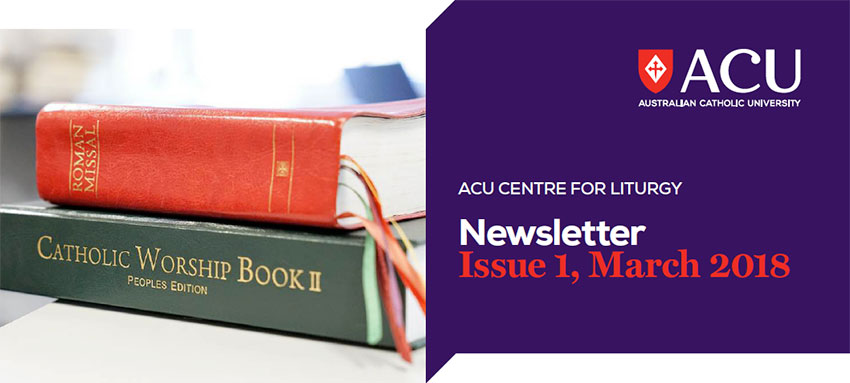

Welcome from the director
Welcome to the first newsletter of the ACU Centre for Liturgy. A university based centre designed to promote liturgical education, formation and professional development is something new in the Australian Catholic landscape. ACU’s support of this Centre, in collaboration with the Australian Catholic Bishops Conference, is enabling a widespread renewal of interest in the liturgy, which is central to the life of the Catholic Church: in our parishes, schools, universities and other worship contexts.
Our aim in this newsletter is to update you on our activities, educational and formation opportunities, and academic courses in liturgy, sacraments and the sacred arts offered through ACU’s Faculty of Theology and Philosophy, and to share some fresh insights into liturgical, sacramental and artistic topics.
Included here are several short articles focusing on liturgical aspects of the season of Lent. Sharon Boyd offers an engaging reflection on the Lenten pilgrimage and Jason McFarland shares some insights into singing well during Lenten liturgies. We look forward to introducing a range of liturgical, sacramental, educational and artistic voices and perspectives through articles in future newsletters.
We encourage you to get in touch with us to learn more about the Centre’s educational opportunities for clergy, pastoral associates, parish ministers, teachers and religious education leaders. Our contact details are found below. Our staff are happy to come to where you are and to tailor our programs to meet your specific needs.
On behalf of the ACU Centre for Liturgy, I offer you our best wishes for the holy days ahead.
Professor Clare V. Johnson
Director, ACU Centre for Liturgy
Professor of Liturgical Studies & Sacramental Theology, Faculty of Theology & Philosophy

From our Board of Advisors
An essential part of the ACU Centre for Liturgy from its establishment has been the twice yearly meetings of the Board of Advisors.
In this early stage of growth, the members of the Board (who represent various constituencies in the Church and the University) have offered advice and support to the Centre staff as they embark on this important initiative to enhance the academic and pastoral study of liturgy. The various “voices” at the table are able to reflect on the pressing needs in rural and metropolitan parishes, schools and other Church agencies on what needs to be addressed in improving the liturgical experience for the People of God. As new initiatives unfold in the future, our hope would be that the Centre becomes a vital part in resourcing the liturgical life of the Church in Australia.
Very Rev Peter G. Williams is Vicar General and Moderator of the Curia, Diocese of Parramatta.

News and recent events
Short courses in theology
Professor Clare Johnson presented the lecture “Why do we baptise infants? Exploring infant faith and personhood in Baptism” as part of the Sydney short course in theology on 21 February. As part of the Brisbane short course in theology on 21 March, Dr Jason McFarland will present a lecture on “The Death of Jesus in the Paschal Triduum.” Short courses in theology are held twice a year in Adelaide, Brisbane, Canberra, Melbourne, and Sydney.
Find out more

Liturgy Spotlight
Lent – A season of pilgrimage
We all need markers along the journey of life; markers that point us in the right direction and that keep us from getting lost.
On Ash Wednesday we are marked with the sign of the Cross and we embark upon our pilgrimage through Lent. We are encouraged to shed something (food, behaviour) or to take something on and make changes in our lives; changes that are challenging. The Church gives us the liturgy (sacraments) to mark the way.
In October 2017, I joined a small group of pilgrims from ACU as we walked the final 120 km to Santiago de Compestela in northwest Spain. This ancient pilgrim route leads to the tomb of St James the Apostle and Christians have been walking it for over a thousand years. Camino means “The Way” and it was originally conceived of as a penitential journey that was to be made once in a lifetime. Indeed so challenging is the full length (more than 800 km) that centuries ago many died along the route. Today people have all types of motivations for walking the Camino, but they all shed many creature comforts and carry a pack on their back as they keep their eyes peeled for the next marker. As the Camino provides markers, so too does the Liturgy, especially as we enter and make our way through the season of Lent.
The Gospel of the First Sunday of Lent describes the Spirit driving Jesus out into the desert for forty days where he was tempted by Satan and was with wild beasts and was ministered to by angels. The Camino confronts the pilgrim with the fragility of the mind and body. Blisters, stomach bugs and the heat of the day can hammer one’s ego, and when members of the group ministered to one another, we truly felt the angels in our midst.
The five Sundays of Lent provide not only markers but rest days throughout the season, where our Christian identities can be nourished, where our imperfect lives can be brought to God for healing and where we can be enriched and inspired by people who seek to make the journey with us, such as those in the RCIA with whom we can walk the path in prayer. No matter how long we have been on the path, new encounters with God are always to be had; more spiritual growth awaits us.
With the climax of our Lenten journey at the Easter Vigil, readings of resurrection will lift our hearts as new life enters our communities. The Camino pilgrim reaches their journey’s climax when they enter the tomb of St James the Apostle. The Cathedral of Santiago de Compestela, has a massive botafumero: a giant thurible (censor) that swings the length of the transept, leaving a sweet scent in its wake. Originally it incensed the cathedral to disguise the pungent aromas of tired and filthy pilgrims devoid of water to bathe in. What was originally a necessary practicality has now evolved into an important aspect of the liturgy itself as the incense represents the many prayers offered by the pilgrims, making their way heavenward. The 80kg silver botafumero takes eight men to manoeuvre and in full flight it is mesmerising as it travels towards the assembly like a cannon ball and then rises into the heights of the cathedral. My spirit soared along with it; those blisters were worth it!
The Lenten journey may be challenging, but the experience of Easter will make it worthwhile. Allow the liturgies to carry you.
Ms Sharon Boyd is a graduate of Notre Dame (USA) with an MA specialising in liturgy. She has an MA in pastoral care and counselling and a strong interest in spirituality. Sharon has been tutoring in liturgy, sacramental theology and the Core Curriculum at ACU since 2015.

Sharing good practice
Singing in a season of repentance
Lent is a season of repentance. As Paschale Solemnitatis (no. 14) explains, “the virtue and practice of penance form a necessary part” of Lent. Yet, we also hear in the General Instruction of the Roman Missal (no. 39) that “singing is the sign of the heart’s joy.” What place, then, does singing have in the season of Lent?
We find some answers to this question by digging deeper into the Church’s understanding of the season. Singing expresses joy, yes, but as we know from the Psalms it is also in song that human beings most fervently express lament (cf. Sing to the Lord, no. 87). Even more importantly, Lent is not primarily a season of repentance, but rather of preparation in which repentance plays a part. The GIRM (no. 27) and the Ceremonial of Bishops (no. 249) are clear on this matter: the purpose of Lent is to prepare catechumens and all of the faithful for Easter. As such, singing in Lent is not only an expression of lament, but also an expression of anticipatory joy as we look toward Easter. Even further, during Lent the faithful recall their own baptisms and “pray for those who in the forthcoming paschal Vigil will receive the sacraments of Christian initiation” (PS, no. 8). Truly, we keep vigil with those preparing to enter the Church at Easter. Singing together plays a crucial function in our Lenten liturgies, then, because it “fosters oneness of spirit” (Sacrosanctum Concilium, no. 112).
The focus of our liturgical-musical preparation in Lent should have a twofold focus: restraint and skilled execution. The Ceremonial of Bishops (no. 252) reminds us that “musical instruments may be played only to give necessary support to the singing” during this season. It is best, therefore, to focus on singing those parts of the Mass most easily sung without accompaniment—and singing them as well as possible. By design, these are the texts most importantly sung at Mass: the Lenten Gospel Acclamation, Sanctus, Memorial Acclamation, and Doxology of the Eucharistic Prayer (cf. GIRM, 34-40). Given the penitential dimension of the season, we might also sing the Penitential Act. Even further, we can help fellow worshippers to focus their Lenten reflection through the more ample use of silence, particularly in place of the preparation and recessional songs. There is a place, of course, for other singing—particularly at the entrance and communion processions, as well as during the Responsorial Psalm.
Lenten beauty is simple beauty. Liturgical song, if it is done well, will allow the Lenten liturgies to do their work of preparing the faithful for Easter joy.
Jason J. McFarland, PhD is the Assistant Director of ACU Centre for Liturgy, and a lecturer in Liturgical Studies & Sacramental Theology, Faculty of Theology & Philosophy.
Engage our expertise
Improve liturgical celebrations in your parish: We provide specialised training and formation workshops for parish ministers and liturgical musicians on a variety of topics.
Deepen your understanding of the liturgy as a Catholic educator: Our professional development (PD) sessions and workshops focus on helping teachers and religious education leaders to enhance worship within school contexts.
Develop your skills as a presider at liturgy: Our specialised PD sessions for clergy include topics such as: The art of presiding at worship, The art and craft of preaching, Gaining confidence in presidential singing and Navigating new liturgical translations.
Bring our experts to you: Our academics and professional specialists can deliver keynote addresses, public lectures, and conference workshops on topics of interest to your organisation.
The Liturgy Nexus
The Nexus is an online network for professional Catholic liturgists, academics and those working in areas related to liturgy, sacraments and the sacred arts. It is a subscription based, closed network for conversation on liturgical issues, resource sharing and problem solving. Memberships are available for individuals:
- involved in Catholic liturgical ministry and scholarship on a local, national, and international level
- with tertiary qualifications in liturgy, sacraments and the sacred arts
- working professionally in liturgy-related professions (e.g. liturgical musicians, artists, architects), or
- currently studying postgraduate level liturgy, sacraments and the sacred arts.
The Liturgy Nexus went live on 1 March 2018, and membership is granted to applicants who meet the eligibility criteria. The annual membership fee is $30.00 and is renewable yearly, on or before 1 March.
Apply now
Support our work in rural and low income parishes
Donations can be made via the Give Now portal on our website. ACU is a public not-for-profit university. Gifts of $2 or more are tax deductible and you can be assured that 100% of your gift will be applied directly to provide essential formative liturgical education in areas of need. We also accept endowments, pledges, bequests, and gifts in kind.
Contact us





